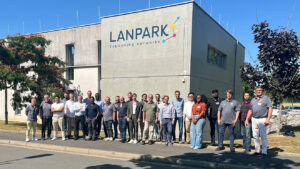Throughout 2025, Altice Labs has strengthened its positioning in next-generation access networks by presenting its 50G-PON technology across several initiatives — from interoperability testing at the Broadband Forum Plugfest, live demonstrations at Network X and expert discussions at the APDC Digital Business Congress.
50G-PON OLT debuts at Broadband Forum Plugfest
In July, Altice Labs participated in the Broadband Forum PON Plugfest, held in Tours, France, where it unveiled a prototype of the 50G-PON Optical Line Terminal (OLT) lice card.
Validated under ITU-T G.9804.x HS-PON and Broadband Forum TP-255 / TR-309 interoperability test plans, the equipment positioned Altice Labs as the only vendor to present a 50G-PON OLT at the event. The successful results reinforced Altice Labs’ leadership and confirmed the product’s development path toward large-scale future deployments, ensuring interoperability across the market’s network ecosystem. The event also provided an opportunity for Altice Labs to reaffirm its roadmap for the next generation of ultra-high-speed passive optical networks.
APDC Digital Business Congress: envisioning the future of PON
Earlier September, Altice Labs joined PicAdvanced in a live episode of the APDC “Dot Topics” podcast, part of the 34th Digital Business Congress.
In this session, Cláudio Rodrigues (Altice Labs) and Francisco Rodrigues (PicAdvanced) discussed the evolution from GPON and XGS-PON to 50G-PON technologies, addressing critical topics such as coexistence, photonic integration, energy efficiency, and the potential of digital twins and immersive applications enabled by higher-capacity optical networks.
Network X: 50G-PON takes center stage in Paris
In October, Altice Labs stood out once again at Network X, one of the telecommunications industry’s premier events, held at Porte de Versailles in Paris, where the 50G-PON solution was showcased throughout the three days.
Altice Labs also led a session on this topic, exploring the challenges and opportunities of implementing new generations of optical access networks.



